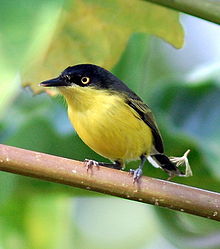- Common Tody-flycatcher
-
Common Tody-Flycatcher 
Conservation status Scientific classification Kingdom: Animalia Phylum: Chordata Class: Aves Order: Passeriformes Family: Tyrannidae Genus: Todirostrum Species: T. cinereum Binomial name Todirostrum cinereum
(Linnaeus, 1766)The Common Tody-Flycatcher or Black-fronted Tody-Flycatcher, Todirostrum cinereum, is a very small passerine bird in the tyrant flycatcher family. It breeds from southern Mexico to northwestern Peru, eastern Bolivia and southern Brazil.
The Common Tody-Flycatcher is a tiny, big-headed bird, 9.5-10.2 cm long, weighing 6.5-6.8 g, and with a long, straight black bill. The upper head is black, shading to dark grey on the nape and dark olive-green on the rest of the upperparts. The usually cocked tail is black with white tips, and the wings are blackish with two yellow wing bars and yellow edging to the feathers. The underparts are entirely yellow. Sexes are similar, but young birds have a greyer upper head, buff wing markings, and paler underparts.
Males of this species have a rapid grasshopper-like ticking te’e’e’e’e’e’t call something like a Tropical Kingbird, and a dawn song consisting of a very fast high tic repeated up to 110 times a minute for minutes on end.
It is a very common inhabitant in gardens, shady plantations, second growth and the edges and clearings of forest, although it avoids the dense interior of mature woodland and also arid areas. The Common Tody-Flycatcher is usually seen in pairs, making rapid dashing sallies or hovering to pick small arthropods off the vegetation[1]. It often wags its tail as it moves sideways along branches.
It breeds from sea level to 1150 meters altitude, locally 1500 meters. Both male and female birds build a pouch nest with a visored side entrance, which is usually suspended from a thin branch or vine 1-5 meters high in a tree, though occasionally it can go up to 30 meters. The female incubates the two usually unspotted white eggs for the 15–16 days prior to hatching.
Common names
- English: Black-fronted Tody-Flycatcher, Common Tody-Flycatcher.
- Spanish: Titirijí común, titirijí lomicenizo, espatulilla amarilla, mosquerito común.
- Portuguese: Ferreirinho, Ferreirinho-relógio, Reloginho, Relógio, Sebinho-relógio.
Footnotes
- ^ de A. Gabriel & Pizo (2005)
References
- BirdLife International (2009). "Todirostrum cinereum". IUCN Red List of Threatened Species. Version 2011. International Union for Conservation of Nature. http://www.iucnredlist.org/apps/redlist/details/145030. Retrieved 1 October 2011.
- de A. Gabriel, Vagner & Pizo, Marco A. (2005): Foraging behavior of tyrant flycatchers (Aves, Tyrannidae) in Brazil. Revista Brasileira de Zoologia 22(4): 1072–1077. doi:10.1590/S0101-81752005000400036 PDF fulltext
- Hilty, Steven L. (2003): Birds of Venezuela. Christopher Helm, London. ISBN 0-7136-6418-5
- Stiles, F. Gary & Skutch, Alexander Frank (1989): A guide to the birds of Costa Rica. Comistock, Ithaca. ISBN 0-8014-9600-4
External links
- Common Tody-Flycatcher videos on the Internet Bird Collection
- Common Tody-Flycatcher photo gallery VIREO–(with/ picture of hanging pouch nest) Photo-High Res
- Photo-High Res(thumbnail); Article fermatainc
Categories:- IUCN Red List least concern species
- Todirostrum
- Birds of South America
- Birds of Ecuador
- Birds of the Guianas
- Birds of the Amazon Basin
- Birds of Central America
- Birds of the Yucatán Peninsula region
Wikimedia Foundation. 2010.

